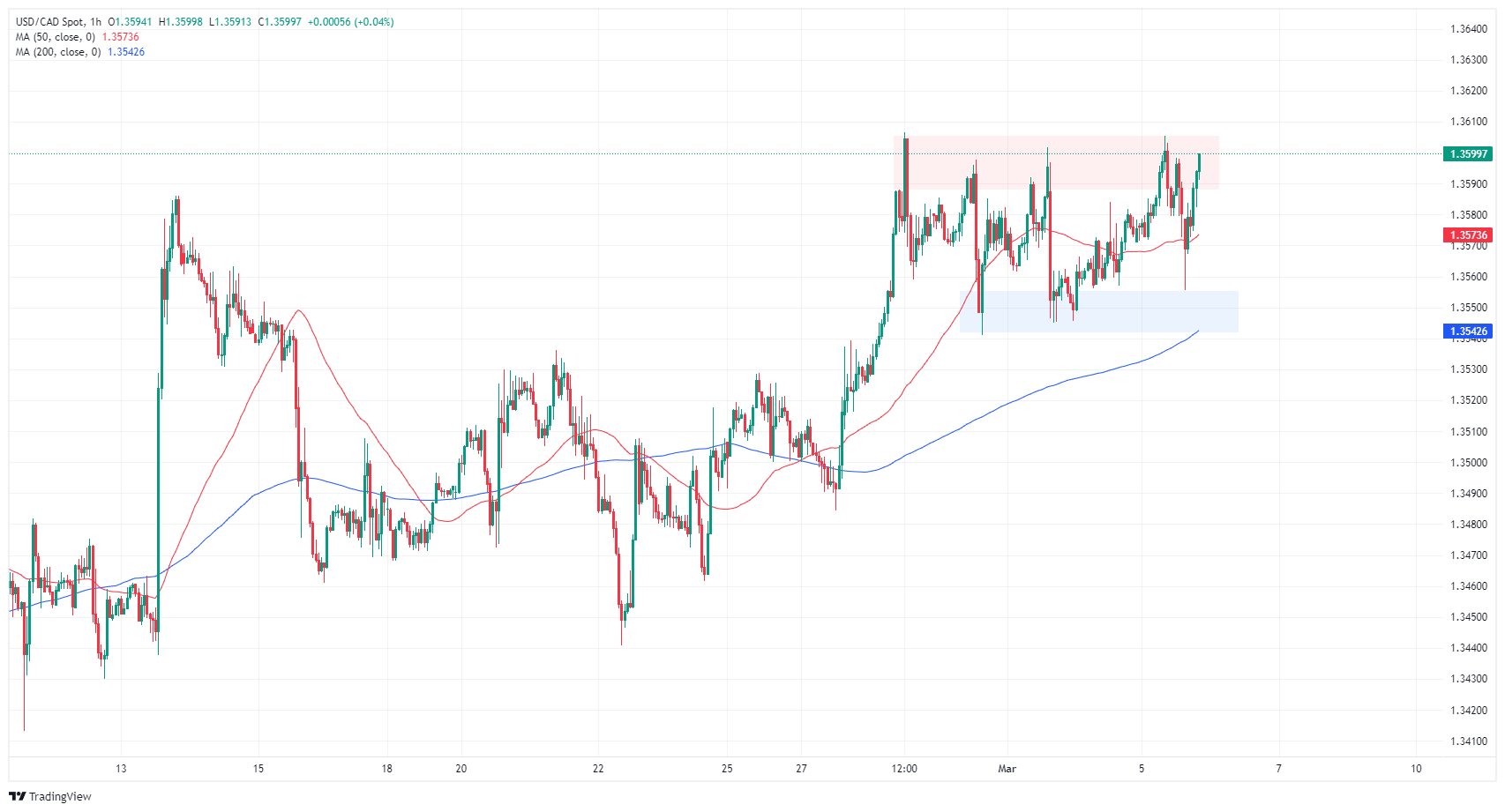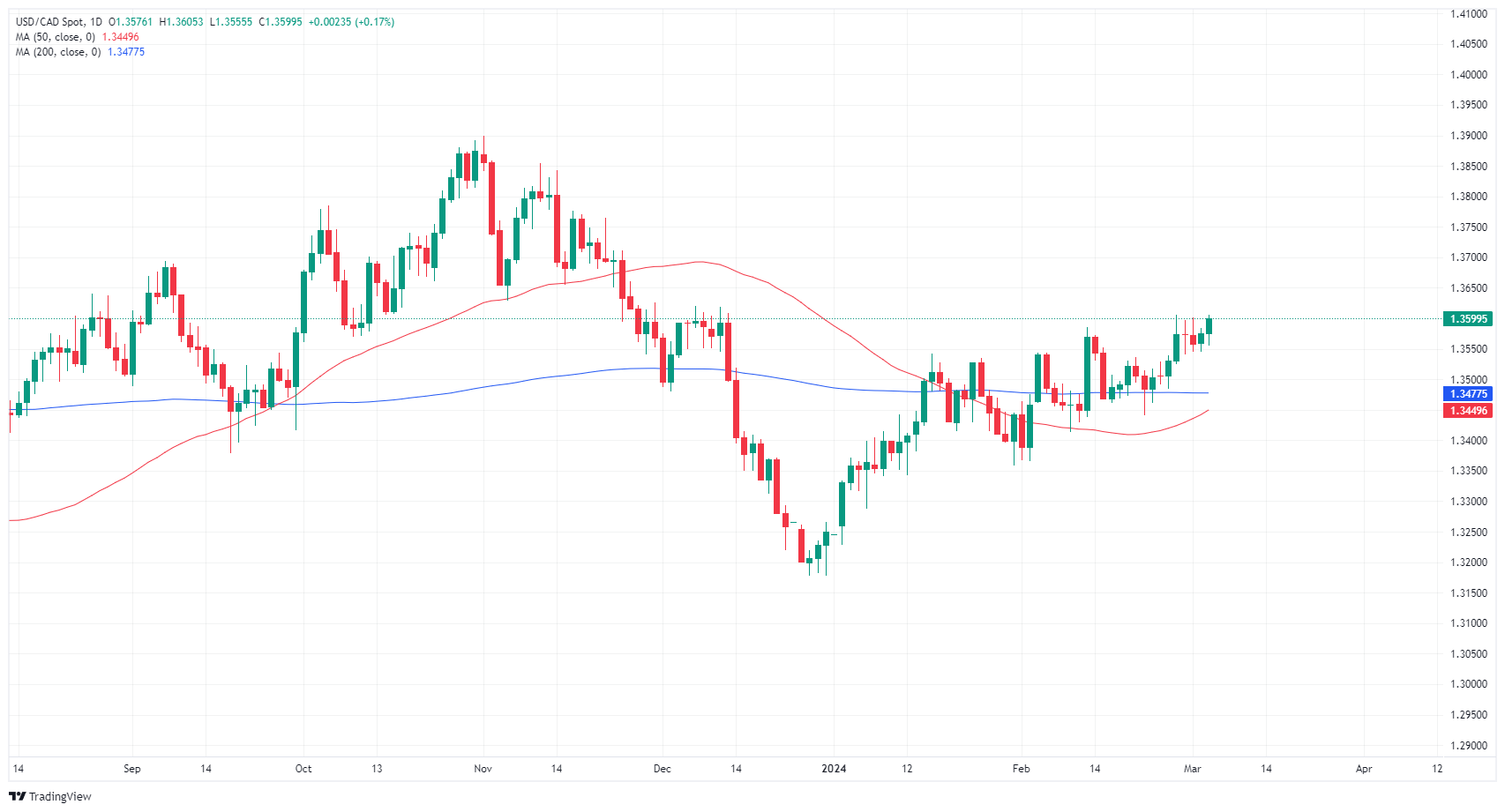- US data prints miss the mark, ISM PMI and Factory Orders flub forecasts.
- Canada readies for another BoC rate call on Wednesday.
- CAD is softer on the day, only finding gains against USD.
The Canadian Dollar (CAD) climbed against the US Dollar (USD) on Tuesday before falling back once more after the US ISM Services Purchasing Managers Index (PMI) and US Factory Orders both missed forecasts. Market hopes for an accelerated path toward Federal Reserve (Fed) rate cuts are pinning back into the high end as US economic figures tease a steepening economic contraction in the US.
The Bank of Canada (BoC) makes another appearance on Wednesday to deliver what is broadly expected to be another rate hold at 5.0%. ADP Employment Change for the US will dwarf moves from the BoC’s Governor Tiff Macklem, and Fed Chairman Jerome Powell will be making his first of two appearances to testify about the Fed’s Semi-Annual Monetary Policy Report before the US Congress’ House Financial Services Committee.
Daily digest market movers: CAD pares Greenback losses after US data softens
- February’s US ISM Services PMI declined to 52.6 versus the forecast of 53.0, 53.4 previously.
- ISM Services Prices Paid also fell to 58.6 from the previous 64.0.
- US Factory Orders in January slid to -3.6% MoM, missing the -2.9% forecast, and the previous month’s print saw a downside revision to -0.3% from 0.2%.
- Markets shrugged off an uptick in the US S&P Global Composite PMI for February, which ticked up to 52.5 from the forecast hold at 51.4.
- Wednesday’s US ADP Employment Change is forecast to print at 150K versus the previous 107K.
- The BoC is expected to hold rates at 5.0% on Wednesday.
- BoC Preview: Forecasts from seven major banks
Canadian Dollar price today
The table below shows the percentage change of Canadian Dollar (CAD) against listed major currencies today. Canadian Dollar was the weakest against the Japanese Yen.
| USD | EUR | GBP | CAD | AUD | JPY | NZD | CHF | |
| USD | 0.02% | -0.07% | 0.17% | 0.08% | -0.40% | 0.21% | -0.22% | |
| EUR | -0.03% | -0.11% | 0.15% | 0.03% | -0.42% | 0.16% | -0.22% | |
| GBP | 0.08% | 0.10% | 0.24% | 0.13% | -0.32% | 0.28% | -0.13% | |
| CAD | -0.19% | -0.16% | -0.27% | -0.14% | -0.58% | 0.00% | -0.38% | |
| AUD | -0.09% | -0.04% | -0.15% | 0.12% | -0.46% | 0.12% | -0.26% | |
| JPY | 0.39% | 0.41% | 0.29% | 0.57% | 0.42% | 0.61% | 0.19% | |
| NZD | -0.21% | -0.17% | -0.29% | -0.03% | -0.13% | -0.63% | -0.39% | |
| CHF | 0.21% | 0.22% | 0.12% | 0.38% | 0.27% | -0.20% | 0.41% |
The heat map shows percentage changes of major currencies against each other. The base currency is picked from the left column, while the quote currency is picked from the top row. For example, if you pick the Euro from the left column and move along the horizontal line to the Japanese Yen, the percentage change displayed in the box will represent EUR (base)/JPY (quote).
Technical analysis: Canadian Dollar broadly softer on Tuesday, but pares losses against Greenback
The Canadian Dollar (CAD) is broadly flat to lower against the majority of its major currency peers on Tuesday, shedding a quarter of a percent against both the Pound Sterling (GBP) and the Japanese Yen (JPY). The CAD is flat against the New Zealand Dollar (NZD), trading within a tenth of a percent of Tuesday’s opening bids.
The USD/CAD rose early Tuesday, getting rejected once again from the 1.3600 handle and trading back into congestion. The USD eased back to a session low of 1.3555 against the Canadian Dollar before the pair recovered to familiar territory near 1.3580.
USD/CAD continues to knock into the 1.3600 handle as daily candles pull into congestion. The pair continues to find support above the 200-day Simple Moving Average (SMA) at 1.3477.
USD/CAD hourly chart
USD/CAD daily chart
Canadian Dollar FAQs
The key factors driving the Canadian Dollar (CAD) are the level of interest rates set by the Bank of Canada (BoC), the price of Oil, Canada’s largest export, the health of its economy, inflation and the Trade Balance, which is the difference between the value of Canada’s exports versus its imports. Other factors include market sentiment – whether investors are taking on more risky assets (risk-on) or seeking safe-havens (risk-off) – with risk-on being CAD-positive. As its largest trading partner, the health of the US economy is also a key factor influencing the Canadian Dollar.
The Bank of Canada (BoC) has a significant influence on the Canadian Dollar by setting the level of interest rates that banks can lend to one another. This influences the level of interest rates for everyone. The main goal of the BoC is to maintain inflation at 1-3% by adjusting interest rates up or down. Relatively higher interest rates tend to be positive for the CAD. The Bank of Canada can also use quantitative easing and tightening to influence credit conditions, with the former CAD-negative and the latter CAD-positive.
The price of Oil is a key factor impacting the value of the Canadian Dollar. Petroleum is Canada’s biggest export, so Oil price tends to have an immediate impact on the CAD value. Generally, if Oil price rises CAD also goes up, as aggregate demand for the currency increases. The opposite is the case if the price of Oil falls. Higher Oil prices also tend to result in a greater likelihood of a positive Trade Balance, which is also supportive of the CAD.
While inflation had always traditionally been thought of as a negative factor for a currency since it lowers the value of money, the opposite has actually been the case in modern times with the relaxation of cross-border capital controls. Higher inflation tends to lead central banks to put up interest rates which attracts more capital inflows from global investors seeking a lucrative place to keep their money. This increases demand for the local currency, which in Canada’s case is the Canadian Dollar.
Macroeconomic data releases gauge the health of the economy and can have an impact on the Canadian Dollar. Indicators such as GDP, Manufacturing and Services PMIs, employment, and consumer sentiment surveys can all influence the direction of the CAD. A strong economy is good for the Canadian Dollar. Not only does it attract more foreign investment but it may encourage the Bank of Canada to put up interest rates, leading to a stronger currency. If economic data is weak, however, the CAD is likely to fall.
Bank of Canada FAQs
The Bank of Canada (BoC), based in Ottawa, is the institution that sets interest rates and manages monetary policy for Canada. It does so at eight scheduled meetings a year and ad hoc emergency meetings that are held as required. The BoC primary mandate is to maintain price stability, which means keeping inflation at between 1-3%. Its main tool for achieving this is by raising or lowering interest rates. Relatively high interest rates will usually result in a stronger Canadian Dollar (CAD) and vice versa. Other tools used include quantitative easing and tightening.
In extreme situations, the Bank of Canada can enact a policy tool called Quantitative Easing. QE is the process by which the BoC prints Canadian Dollars for the purpose of buying assets – usually government or corporate bonds – from financial institutions. QE usually results in a weaker CAD. QE is a last resort when simply lowering interest rates is unlikely to achieve the objective of price stability. The Bank of Canada used the measure during the Great Financial Crisis of 2009-11 when credit froze after banks lost faith in each other’s ability to repay debts.
Quantitative tightening (QT) is the reverse of QE. It is undertaken after QE when an economic recovery is underway and inflation starts rising. Whilst in QE the Bank of Canada purchases government and corporate bonds from financial institutions to provide them with liquidity, in QT the BoC stops buying more assets, and stops reinvesting the principal maturing on the bonds it already holds. It is usually positive (or bullish) for the Canadian Dollar.
Information on these pages contains forward-looking statements that involve risks and uncertainties. Markets and instruments profiled on this page are for informational purposes only and should not in any way come across as a recommendation to buy or sell in these assets. You should do your own thorough research before making any investment decisions. FXStreet does not in any way guarantee that this information is free from mistakes, errors, or material misstatements. It also does not guarantee that this information is of a timely nature. Investing in Open Markets involves a great deal of risk, including the loss of all or a portion of your investment, as well as emotional distress. All risks, losses and costs associated with investing, including total loss of principal, are your responsibility. The views and opinions expressed in this article are those of the authors and do not necessarily reflect the official policy or position of FXStreet nor its advertisers. The author will not be held responsible for information that is found at the end of links posted on this page.
If not otherwise explicitly mentioned in the body of the article, at the time of writing, the author has no position in any stock mentioned in this article and no business relationship with any company mentioned. The author has not received compensation for writing this article, other than from FXStreet.
FXStreet and the author do not provide personalized recommendations. The author makes no representations as to the accuracy, completeness, or suitability of this information. FXStreet and the author will not be liable for any errors, omissions or any losses, injuries or damages arising from this information and its display or use. Errors and omissions excepted.
The author and FXStreet are not registered investment advisors and nothing in this article is intended to be investment advice.
Recommended content
Editors’ Picks

EUR/USD stays near 1.0400 in thin holiday trading
EUR/USD trades with mild losses near 1.0400 on Tuesday. The expectation that the US Federal Reserve will deliver fewer rate cuts in 2025 provides some support for the US Dollar. Trading volumes are likely to remain low heading into the Christmas break.

GBP/USD struggles to find direction, holds steady near 1.2550
GBP/USD consolidates in a range at around 1.2550 on Tuesday after closing in negative territory on Monday. The US Dollar preserves its strength and makes it difficult for the pair to gain traction as trading conditions thin out on Christmas Eve.

Gold holds above $2,600, bulls non-committed on hawkish Fed outlook
Gold trades in a narrow channel above $2,600 on Tuesday, albeit lacking strong follow-through buying. Geopolitical tensions and trade war fears lend support to the safe-haven XAU/USD, while the Fed’s hawkish shift acts as a tailwind for the USD and caps the precious metal.

IRS says crypto staking should be taxed in response to lawsuit
In a filing on Monday, the US International Revenue Service stated that the rewards gotten from staking cryptocurrencies should be taxed, responding to a lawsuit from couple Joshua and Jessica Jarrett.

2025 outlook: What is next for developed economies and currencies?
As the door closes in 2024, and while the year feels like it has passed in the blink of an eye, a lot has happened. If I had to summarise it all in four words, it would be: ‘a year of surprises’.

Best Forex Brokers with Low Spreads
VERIFIED Low spreads are crucial for reducing trading costs. Explore top Forex brokers offering competitive spreads and high leverage. Compare options for EUR/USD, GBP/USD, USD/JPY, and Gold.